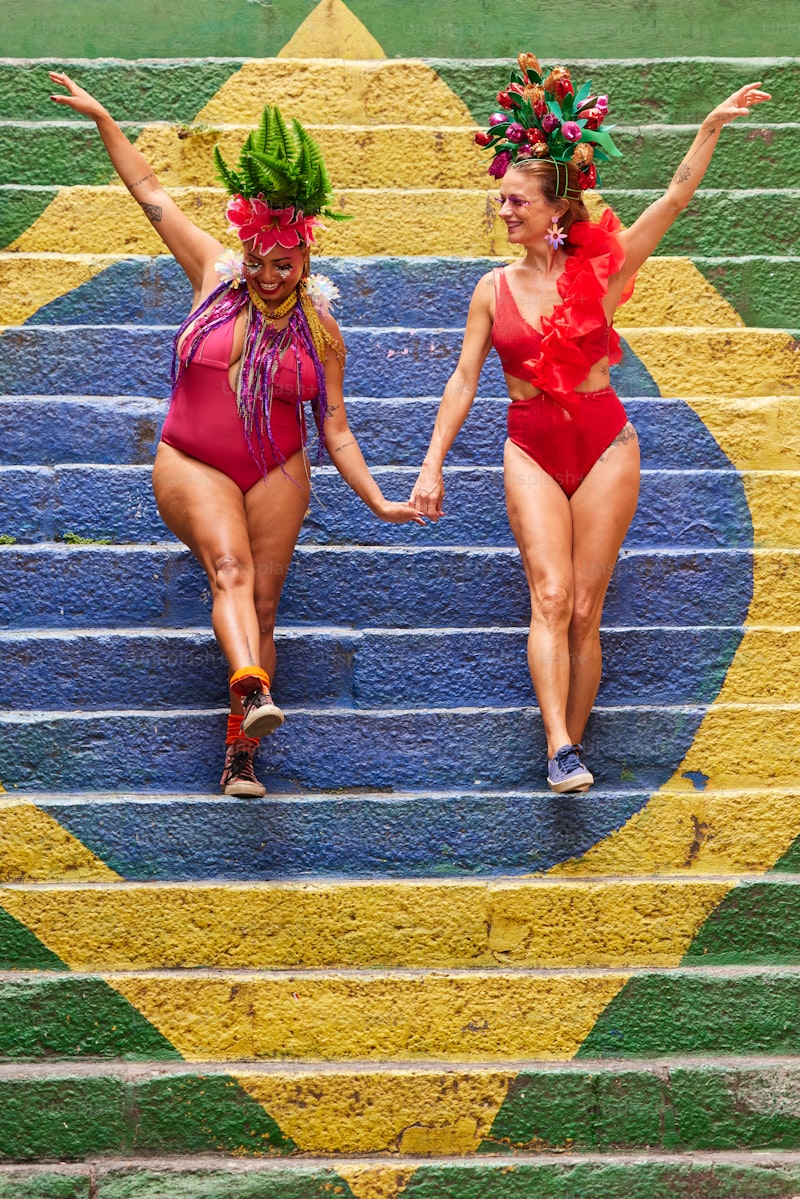Carnival, celebrated across many countries including Brazil and Colombia, is a spectacle of color and energy. It’s a time when streets come alive with samba rhythms, elaborate costumes, and exuberant parades. Carnival isn’t just a festival; it’s a celebration of life itself, where locals and tourists alike join in the festivities, dancing until dawn and embracing the infectious joy.
Moving to the Andean region, Inti Raymi stands as a testament to the ancient Incan civilization’s reverence for the sun god, Inti. Held annually in Peru, this festival marks the winter solstice with rituals that honor nature’s cycles. Participants clad in traditional attire perform ceremonial dances and offer gratitude for the sun’s warmth and light, reflecting a deep spiritual connection that spans centuries.
Further south in Argentina, the Tango Festival in Buenos Aires captivates with its passionate dance performances and music. Tango isn’t just a dance here; it’s a cultural emblem that embodies the soul of Argentina. The festival attracts dancers from around the world who converge to compete, learn, and revel in the sensual rhythms of this iconic dance form.

In Ecuador, the Diablada de Píllaro merges indigenous traditions with Spanish influences in a vibrant display of masks, music, and folklore. This carnival-like festival honors the Virgin of Píllaro with parades where dancers, adorned as devils (diablos), engage in lively performances that blend mythology and history.
Across these diverse celebrations, one finds a common thread: a profound respect for heritage and community. These festivals aren’t merely spectacles; they are living traditions that bridge the past with the present, inviting everyone to partake in the cultural richness of South America. Whether it’s the rhythmic beats of Carnival or the solemn rituals of Inti Raymi, each festival offers a glimpse into the heart and soul of this enchanting continent.
Samba and Spice: Exploring Brazil’s Vibrant Carnival and Beyond
Brazil’s Carnival is not just an event; it’s a cultural explosion that ignites the senses and captures hearts worldwide. At the heart of this spectacle is samba, the rhythmic dance that embodies the soul of Brazilian culture. Imagine yourself amidst a sea of vibrant costumes, pulsating rhythms, and infectious energy that reverberates through the streets of Rio de Janeiro. This is Carnival, a celebration like no other, where music, dance, and sheer joy blend into an unforgettable experience.
Samba, with its origins deeply rooted in Afro-Brazilian traditions, is more than just a dance. It’s a symbol of unity and expression, bringing together people from all walks of life to revel in the spirit of togetherness. The intricate footwork and mesmerizing beats of samba drums transport you to another realm, where every step tells a story of resilience and passion.
Beyond the pulsating streets of Carnival lies Brazil’s diverse tapestry of flavors and landscapes. From the pristine beaches of Copacabana to the lush Amazon rainforest, Brazil beckons adventurers and nature enthusiasts alike. Indulge in the tantalizing tastes of Brazilian cuisine, where feijoada and caipirinhas tantalize the taste buds, reflecting the country’s rich culinary heritage.
Whether you’re exploring the bustling city life of São Paulo or unwinding on the tranquil shores of Bahia, Brazil offers a kaleidoscope of experiences that leave a lasting impression. Dive into the rhythms of Bossa Nova, lose yourself in the colors of street art in São Paulo’s Vila Madalena, or embark on a wildlife safari in the Pantanal wetlands.
Brazil’s Carnival is more than an event; it’s a testament to the country’s vibrant spirit and cultural richness. As you immerse yourself in the sights, sounds, and flavors of Brazil, you’ll discover a land where every moment is infused with passion and wonder.
This article captures the essence of Brazil’s Carnival and its cultural significance, while also highlighting the country’s diverse attractions beyond the festivities.
From Andean Peaks to Amazonian Beats: Unveiling South America’s Diverse Festivities
One of the most iconic festivals is Carnival, a riotous extravaganza celebrated across many countries but perhaps most famously in Rio de Janeiro, Brazil. Here, samba dancers in elaborate costumes sway to the pulsating rhythms of drums, creating a spectacle of joy and unity. The streets come alive with parades and street parties, where locals and visitors alike join in the revelry, making it a truly unforgettable experience.
Moving further south, Argentina’s Tango Festival in Buenos Aires is a celebration of passion and elegance. Tango, with its intricate footwork and emotional intensity, takes center stage as dancers showcase their skill and storytelling through movement. The festival not only honors this iconic dance but also serves as a reminder of Argentina’s cultural depth and artistic prowess.
In Peru, the Inti Raymi festival pays homage to the Sun God, Inti, with colorful processions and ancient rituals held in the historic capital of the Inca Empire, Cusco. Against the backdrop of the majestic Andes Mountains, locals dressed in traditional attire perform dances and ceremonies that have been passed down through generations, preserving their indigenous roots and spiritual beliefs.
Meanwhile, in Colombia, the Barranquilla Carnival stands out as one of the largest carnivals in the world. Bursting with music genres like cumbia and vallenato, the carnival is a fusion of African, Indigenous, and Spanish influences, reflecting Colombia’s multicultural heritage. It’s a time when locals showcase their craftsmanship in crafting intricate masks and costumes, each with its own symbolic meaning.
Across the vast Amazon rainforest, indigenous tribes celebrate their unique festivals, such as the Yawar Fiesta in Peru’s Apurímac region, where communities honor the Pachamama (Mother Earth) through ritualistic bullfighting. These rituals not only preserve ancient traditions but also underscore the deep spiritual connection between these communities and their natural surroundings.
South America’s festivals are more than just events; they are living expressions of cultural identity and resilience. They invite travelers to immerse themselves in a world where music, dance, and tradition intertwine to create moments of awe and inspiration. Whether amidst the peaks of the Andes or the rhythms of the Amazon, each festival tells a story of resilience, unity, and the enduring spirit of its people.
Color, Music, and Tradition: The Essence of Colombia’s Festival de Barranquilla
Imagine walking through streets adorned with a kaleidoscope of colors: bright yellows, deep blues, fiery reds, and lush greens. Every hue tells a story, reflecting the diversity and heritage of Colombia’s regions. The costumes worn during the festival are not just garments but living expressions of history and identity, passed down through generations. From the intricate designs of the dresses worn by the Carnival Queen to the elaborate masks and headdresses, each detail speaks volumes about the craftsmanship and creativity ingrained in Colombian culture.
As you navigate through the festivities, your ears are greeted by the rhythmic beats of drums and the melodious notes of traditional Colombian music. Cumbia, porro, and mapalé rhythms fill the air, inviting everyone to dance and revel in the joyous atmosphere. It’s impossible not to be swept away by the infectious energy of the dancers, whose movements are as lively and colorful as the costumes they wear.

The Festival de Barranquilla is not just a display of colors and music; it is a celebration of tradition. Throughout the event, rituals and customs that have been preserved for centuries take center stage. From religious processions honoring local saints to performances that reenact historical events, every aspect of the festival pays homage to Colombia’s past while embracing its present.
In essence, the Festival de Barranquilla is a sensory feast that captures the heart and soul of Colombia. It transcends mere entertainment, offering a profound glimpse into the country’s cultural heritage. Whether you’re a first-time visitor or a seasoned attendee, the festival leaves an indelible mark, leaving you in awe of Colombia’s boundless creativity and unwavering spirit.
Tango and Temptation: Argentina’s Festivals that Dance into the Night
Imagine yourself in the vibrant streets of Buenos Aires, where passion and rhythm fill the air. Argentina, a country renowned for its rich cultural heritage and fiery spirit, comes alive during its lively festivals. Among these, none captivate the soul quite like the Tango festivals that sweep across the nation.

Picture this: the sultry notes of a bandoneón, the sensual embrace of dancers moving in perfect harmony, and the electric atmosphere that enchants spectators. Tango isn’t just a dance here; it’s a cultural phenomenon that embodies the essence of Argentina’s identity. From the bustling capital to the quaintest towns, tango festivals ignite the night with their seductive allure.
One of the most iconic festivals is the Buenos Aires Tango Festival and World Cup, held annually in August. This grand celebration gathers dancers, musicians, and enthusiasts from around the globe to showcase their skills and share their passion for tango. It’s a spectacle where traditional and modern interpretations of tango merge, creating a tapestry of emotions that leave audiences spellbound.
But the allure of tango isn’t confined to Buenos Aires alone. In Rosario, the birthplace of legendary tango composer Astor Piazzolla, the Tango en la Ciudad Festival pays homage to its musical roots. Here, visitors immerse themselves in workshops, performances, and milongas (tango dance parties) that honor Piazzolla’s legacy and the city’s deep connection to tango history.
Further south, in the picturesque city of La Falda, the Tango y Folklore Festival adds a folkloric twist to traditional tango rhythms. Against the backdrop of the stunning Sierras de Córdoba, dancers swirl under the starlit sky, blending Argentine folklore with the sensuality of tango, creating a unique and mesmerizing experience.
Frequently Asked Questions
How can tourists participate in cultural festivals in South America?
Discover how tourists can engage in vibrant cultural festivals across South America. Learn about the diverse range of festivals celebrating music, dance, and local traditions. Find out practical tips on planning your visit, participating respectfully, and immersing yourself in the rich cultural heritage of South American festivals.
How do cultural festivals in South America celebrate local traditions?
Discover how cultural festivals in South America celebrate local traditions through vibrant displays of music, dance, art, and cuisine unique to each region. These festivals showcase indigenous heritage and contemporary culture, fostering community pride and preserving ancestral customs.
What are some famous cultural festivals in South America?
Discover some of South America’s renowned cultural festivals, showcasing vibrant traditions and heritage. From Brazil’s Carnival, a spectacular celebration of music and dance, to Peru’s Inti Raymi, honoring the Incan sun god with colorful ceremonies, these festivals offer a glimpse into rich cultural diversity. Explore Argentina’s Tango Festival, where the passion of tango fills the streets of Buenos Aires, or Colombia’s Barranquilla Carnival, known for its energetic parades and folklore. Each festival highlights unique customs and artistic expressions, attracting visitors from around the world.
When and where do the biggest cultural festivals in South America take place?
Discover when and where the largest cultural festivals in South America take place with this concise FAQ description. Explore vibrant celebrations like Carnival in Rio de Janeiro, Brazil, held annually in February, or the Inti Raymi festival in Cusco, Peru, celebrated in June to honor the Incan sun god. Delve into the rich cultural tapestry of South America through these iconic events.
Why are cultural festivals important in South American societies?
Discover why cultural festivals are crucial in South American societies, exploring their role in preserving traditions, fostering community cohesion, and celebrating cultural diversity. Learn how these events showcase rich heritage, strengthen social bonds, and promote cross-cultural understanding.


